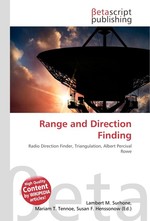Range and Direction Finding
Lambert M. Surhone, Mariam T. Tennoe, Susan F. Henssonow
бумажная книга
Please note that the content of this book primarily consists of articles available from Wikipedia or other free sources online. Range and Direction Finding (RDF) was the initial technique and hardware in Great Britain that eventually came to be called 'radar.' Since the earliest days of radio (wireless), the signals had been used in direction finding on land, sea, and in the air. This was accomplished by rotating the antenna at a receiving station and noting the direction of rotation that gave the maximum signal, thus showing the direction to the transmitting station. The abbreviation DF was often applied to this technique, as well as the receiving equipment. Since radio was being used, the abbreviation RDF came to be commonly used for Radio Direction Finder equipment. Radio direction finding was a passive technique – the receiving station simply detected the signal from the emitting station. If two receiving stations separated by some known distance were used, the method of triangulation might be applied – with restrictions – to give an approximation of the distance to the transmitting station.
Данное издание не является оригинальным. Книга печатается по технологии принт-он-деманд после получения заказа.


